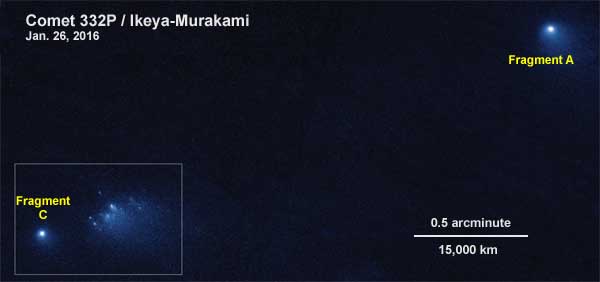Back in January, a team of observers had a hunch that Comet 332P/Ikeya-Murakami was rapidly falling apart — and they were right!

NASA / ESA / D. Jewitt
Pity the unfortunate fate of Comet 332P/Ikeya-Murakami. It quietly drifted in the Kuiper Belt for 4½ billion years, minding its own business. But about 10 million years ago something happened — perhaps a close brush with another object — and this icy little body found itself redirected on a path toward the inner solar system. Over time repeated tugs from Jupiter locked it into a tight, 5½-year-long orbit around the Sun, where it was spotted on November 3, 2010, by Japanese amateurs Kaoru Ikeya and Shigeki Murakami.
Comet 332P might have lived out its days peacefully. But it was suspiciously too bright (8th magnitude) when discovered, and astronomers soon realized it must have undergone some kind of disruptive outburst. Its coma quickly faded from view.
Then, on December 31, 2015, the PanSTARRS 1 telescope captured the comet on its next return to perihelion — except this time around the comet had split into two large fragments. A team led by David Jewitt (University of California, Los Angeles) quickly obtained observing time with the Hubble Space Telescope and found that Comet Ikeya-Murakami had completely disintegrated into at least 25 pieces.

NASA / ESA / D. Jewitt
Over three days in January (26–28) and two more in April (12–13), Hubble's Wide Field Camera 3 captured the comet's demise. Although it's impossible to know for sure, Jewitt's team suspects that the individual pieces must have been roughly 20 to 60 meters (65 to 200 feet) across. How and why it broke apart isn't certain, but a likely cause is that amorphous water ice in the comet's nucleus spontaneously converted to its crystalline form — a runaway reaction that not only generates heat but also releases any trapped gas. (The same scenario might have led to the amazing outburst of Comet 17P/Holmes in November 2007.)
However, as the team details in Astrophysical Journal Letters for September 20th (a full preprint is available here), there's a problem with that interpretation. "No direct evidence for amorphous ice in comets exists," they write, "and it is not clear that gas drag forces could be sufficient to expel fragments 10s of meters in size, as observed, even against the low gravity of [small] parent nucleus."
One thing seems certain: we're unlikely to see much of Comet 332P — if anything of it remains — during its next perihelion in late 2021.
 0
0
Comments
You must be logged in to post a comment.